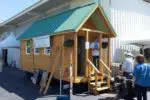The world is getting to be more and more expensive every day. From the cost of real estate and rent to the cost of utility fees and taxes, things certainly aren’t getting any simpler financially. In fact, more and more, it is becoming impossible for individuals to make enough on their own to be able to afford even the basic cost of living. This has led to both spouses working full-time jobs or even two and three part-time jobs, young people staying at home longer because it is too expensive to move out, and more people teaming up with roommates to help share living expenses. But what if you could make all of this go away? What if there was an alternative that could enable you to live a little easier financially? How far would you go for cheaper energy, taxes, and other home-ownership fees?
Would you go tiny?
Tiny living is a growing trend in Alberta. A lot of people are turning to excessive minimalism as a means of being able to afford and manage home ownership costs. But, hey, if the cost of freedom from the stress of monthly bills is simply to shrink everything down to the bare minimum, it doesn’t sound too bad, right? How much can tiny living save you when it comes to finding cheaper energy and reducing other home expenses?
Can a tiny home help you save on energy?
The truth of the matter is that smaller doesn’t necessarily mean cheaper. Tiny houses are trendy, and that may mean they aren’t quite as affordable as you imagine they could be. Plus, they aren’t traditional homes, and that means you aren’t going to be able to get a traditional mortgage, although you may be able to get a loan to help pay for the cost of the tiny house. That said, it is possible to purchase a tiny house without a mortgage—especially if you purchase a kit and build your own home. Compared to traditional living, you may be able to save quite a bit on monthly mortgage payments, but that doesn’t necessarily mean you are getting better bang for your buck. In fact, in a lot of cases, you are actually paying more per square footage when you buy a tiny home than you would be with a traditional home. However, the mortgage is only one aspect. There are a lot of ways that smaller size can contribute to lower expenses—and even cheaper energy.
First of all, tiny means less heating—as long as the house is well-insulated and has good windows. The plus side is that a smaller home means smaller-scale winterization and a higher budget to put towards energy efficient windows, appliances, and lighting. Not to mention, without much room in the home, the number of appliances and electronics you own is going to decrease substantially. It will cost less to light and heat the smaller building simply because there is less space to light and heat. The extremity of the tiny home’s minimalism goes a long way towards providing you with cheaper energy as a result of reduced consumption, but just remember that some of these energy costs (like the energy required to do laundry which will now be offset by transportation and laundromat costs) will be offset into other areas.
A smaller home means minimalistic consumerism, too. You’ll be able to save more per month simply because you won’t be able to store all those extra toys and goodies you were tempted to buy. Since you have a smaller space with fewer items and potentially smaller rebuild costs, your homeowners insurance is going to decrease, too, since a tiny home takes up less property, and often is not considered a permanent structure, you can save on property taxes, too.
However, remember that you don’t have to go tiny to save more.
Tiny living may seem like an extreme step, but you can introduce some of those savings into your traditional home without having to shrink the square footage. You don’t have to own a smaller home to conserve energy or reduce the number of electronics you own and power within it. You can turn the heat or air conditioning down and keep unnecessary lights turned off to save on energy, and you can explore different providers to find cheaper energy rate options and plans tailored for your needs.












